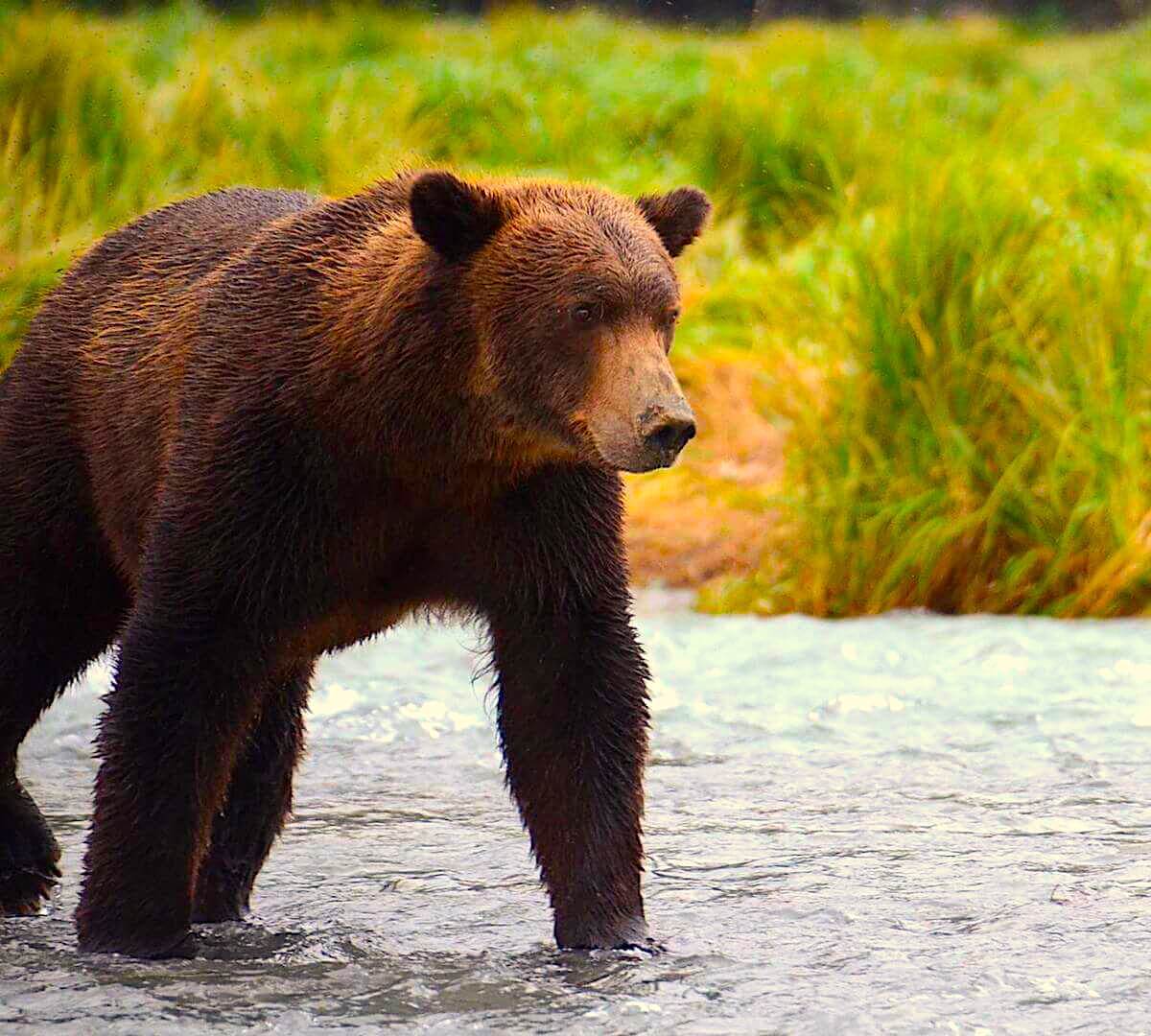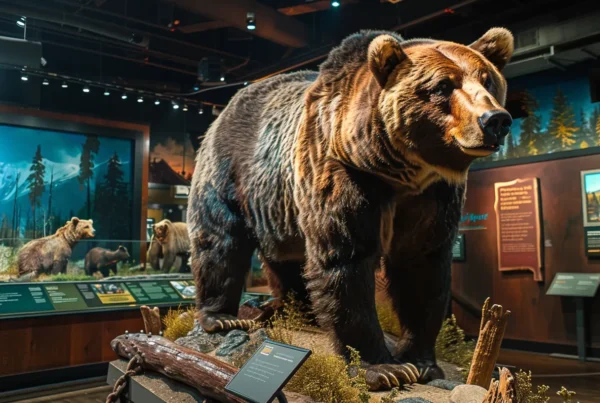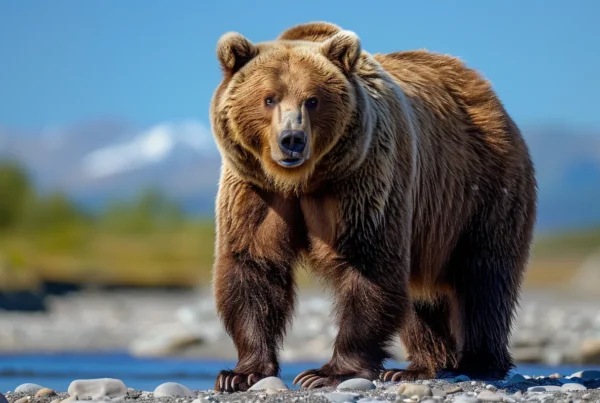A Bear by Any Other Name
The Many Monikers of Ursus Arctos Part 1
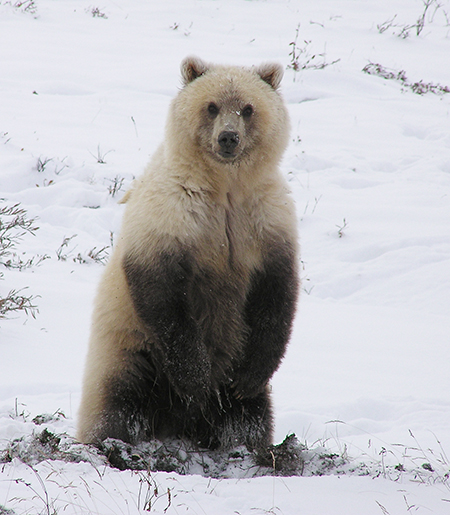
Brown bear or grizzly bear on the Sagavanirktok River. ADF&G
Spend enough time in Alaska and you are bound to hear a number of different terms tossed around in reference to the generally large, usually brownish species of bear found throughout the state. Depending on which region of the Last Frontier you travel to – or even with whom you’re speaking – you are apt to find a general preference for one of these terms over others.
Kick around in the interior or northern portions of the state and locals will tell you of run-ins with “grizzlies.” Drum up conversation with folks anywhere along the coast from Ketchikan to Bristol Bay and you’ll hear talk of “coastal brown bears.” And rub elbows with enough old time sportsmen and sooner or later you’ll hear a tale involving a giant “Kodiak.”
Why is it that there are so many different names for what is purportedly the same animal? Where do these different names come from, and what do they tell us about the bears themselves?
The story is an interesting one, and while it does contain dashes of ecology and evolutionary history, in truth it has less to do with biology than it does with frontier history, scientific posturing, and big game trophy records. But before we get too far into this story, perhaps it would be wise to establish some sort of standard terms to avoid any confusion.
Fortunately for us, an 18th Century Swedish naturalist has already done just that.
The Building Blocks of Classification
Species with wide distributions often have many different names among the varying cultures sharing their range. This of course can be problematic if individuals from these different groups (like scientists, for instance) need to communicate with one another in reference to a particular species.
If you remember back to high school biology class you may recall a gentleman by the name of Carl Linnaeus who solved this issue by formalizing a system of universal biological classification known as binomial nomenclature. Under this system, each species is given a two-part name – generally, but not always, in Latin – that is unique to that organism. Often referred to as the “binomial name” or “scientific name,” it is written in italics and provides a standardized, recognizable term that is familiar to biologists or naturalists anywhere in the world.
In 1758, Linnaeus published the tenth edition of his seminal work Systema Naturae, in which he assigned binomial names to a number of animal species with which he was familiar. One of these, well known to those living in Sweden, was the brown bear. To it, Linnaeus gave the binomial name Ursus arctos, from the words for “bear” in both Latin and ancient Greek, respectively. A bear’s bear, if you will. A fitting title for the most widely distributed member of its family and one of only two of the eight bear species alive today that is not considered vulnerable to the threat of extinction throughout its range.
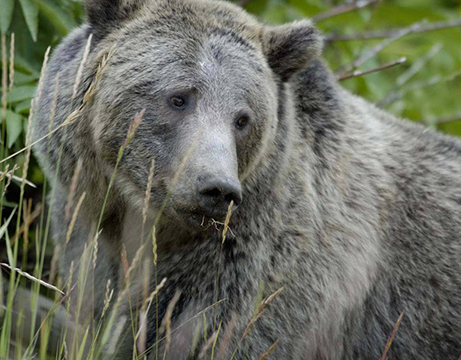
A grizzly bear in Yellowstone National Park. Photo by Terry Tollefsbol/NPS
Circumpolar in distribution, the brown bear (as we will refer to the species generally throughout this article) was historically one of the widest-ranging land mammals, occupying suitable habitats in a band of comparable latitudes spanning across the entirety of Europe, the northern tip of Africa, the Middle East, much of Asia, and the western half of North America, including, of course, Alaska. The sole surviving bear species in Europe since the end of the Pleistocene ice ages, by Linnaeus’ time, the brown bear had already disappeared from large parts of its former range on the continent due to loss of habitat and persecution by agrarian societies.
This was not the case half a world away with the European bears’ distant cousins in North America however, as explorers mapping the acquisitions of an expanding young nation would discover nearly five decades later.
The Birth of the “Grizzly”
In 1803, the Corps of Discovery, led by Meriwether Lewis and William Clark, was tasked by President Thomas Jefferson to travel west across North American to determine an overland route to the Pacific Ocean. An additional objective was to document the geology, native peoples, and plant and animal life of the recently purchased Louisiana Territory.
The Lewis and Clark expedition, as it has come to be known, encountered many animals that were new and unfamiliar to Americans at that time. Among these were the large, sometimes fearsome bears that were altogether different from the black bears of the eastern woodlands. Unbeknownst to the Corps, this was the same species as the brown bear of Europe, but due to much of the Corps having grown up in America – and thus being a number of generations removed from any first-hand knowledge of European bears – the connection wasn’t made.
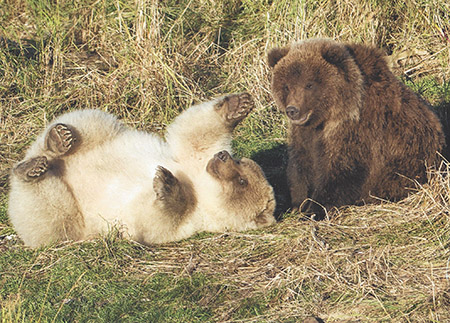
An incredibly light-colored brown bear cub and its more typically colored sibling on the Alaska Peninsula.
The frequency with which early Euro-American explorers, traders, and mountain men refer to grizzlies as “white bears” in their writings leads one to wonder whether color phases such as this were once fairly common in the grizzlies that inhabited the northern Great Plains. Photo courtesy of tomwalkerphotography.com
The bears encountered by the Corps varied widely in appearance, exhibiting a multitude of different coat colors. And while Lewis eventually pieced together that all of these bears were members of the same species, a single, definitive name remained elusive. Throughout the course of their journey, members of the Corps variously referred to the bears as brown, bay, red, yellow, variegated, and curiously, white. Seemingly frustrated with what to call these bears, near the expedition’s end Clark simply began referring to them as bears, “of the large, vicious species.”
Ultimately, it was another name used by the Corps that would eventually become the word of choice to describe these brown bears of the American West: “grizzly.” Although the Corps were not the first to use this name for the species (as it could be found in the journals of a number of earlier explorers who had spent time on the American and Canadian frontiers), it was through their published journals and subsequent works based upon those journals that the term “grizzly bear” was solidified in popular American lexicon.
One of these works, Zoology of North America, was written by American naturalist George Ord in 1815. In it, he provided descriptions of a number of animal species that had been encountered by the Corps, including the grizzly bear. Although the Corps had kept excellent records of the bears they came across, they never attempted to formally describe them in scientific terms, that is, to assign them a binomial name. So, Ord took it upon himself to put forth a scientific name for the animal, designating it a new species, Ursus horribilis, the “terrible bear” (the Corps had a few “bear scares” over the course of their journey, and then, as now, such instances are the ones that seem to lodge themselves into public imagination).
With its new formal description, the grizzly joined the black and polar bear as the third species of bear considered to inhabit North America. This straight-forward view would prevail among both naturalists and the broader American public in the decades following Ord’s publication.
Then, in little over a century from Ord’s original designation, the paradigm would shift dramatically.
Lumpers, Splitters, and Many, Many Bear Skulls
By the dawn of the 20th century, the field of taxonomy (the science of defining and categorizing organisms based on shared characteristics) had expanded considerably since Linnaeus’ time. In addition to a binomial name (designating an organism’s genus and species, respectively), a multitude of additional levels of classification had been created in order to more finely elucidate an organism’s overall place in the biological scheme of things.
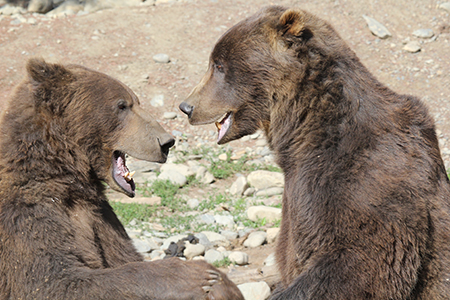
Two captive male bears housed at the Alaska Zoo provide an illustration of the variability in head size and shape among brown bears.
Among these new categories was a formal rank that sat below that of species. This was the “subspecies,” a term used to describe and categorize populations of the same species (itself a sometimes slippery definition) that varied enough in appearance or geographical distribution to warrant taxonomic differentiation. Essentially a formal term for what had variously been referred to as “forms,” “types,” or “races” of animal life, subspecies came to be designated by a trinomial name, tacking a third italicized word onto the end of the familiar binomial name first used by Linnaeus.
One inevitable result of the growth of the taxonomic field was the emergence of different camps of professionals with differing philosophical views on what criteria should be considered relevant when defining various levels of classification. These different groups are most often referred to as “lumpers” and “splitters,” and in the field of taxonomy, their most frequent point of contention is what defines either a species or a subspecies. Lumpers focus more on similarities, and therefore tend to recognize fewer species (or subspecies). Splitters, on the other hand, tend to focus on differences, and therefore recognize more.
C. Hart Merriam was a classic splitter. Known as the “Father of Mammalogy” and head of the Bureau of Biological Survey (the precursor of the U.S. Fish and Wildlife Service), Merriam was a well-known and respected naturalist who had a keen interest in bears. Although there had been a few attempts since George Ord’s initial classification of the grizzly to subdivide the species into two or three others (and conversely, some suggestions – mostly from Europeans – that the grizzly be considered the same species as the brown bear of Europe), Merriam took it upon himself to determine the true number of North American bear species based upon the most up-to-date methods of classification.
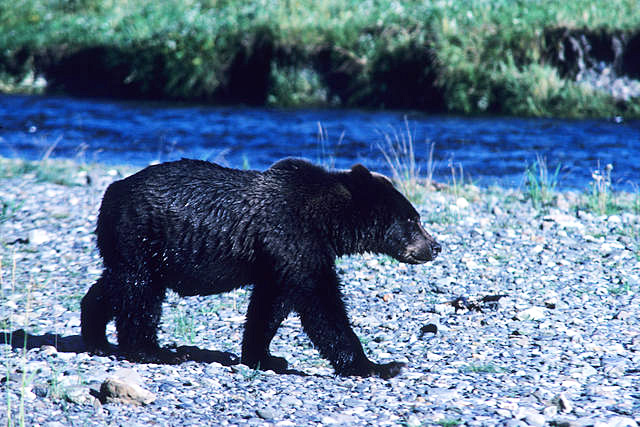
A black-colored brown bear near Pack Creek on Admiralty Island. Photo by Doug Larsen/ADF&G
At the time, taxonomy was based primarily on morphometrics – the measurement of dental, skeletal, and other dimensions of animals’ bodies. So, beginning in 1896 Merriam began a series of investigations into the systematics of North American grizzlies by studying skulls collected from various parts of the continent.
Chief among his initial findings were the morphological distinctions readily apparent between the grizzlies of interior Alaska and the large bears of the coast. He drew comparisons between the latter and the large coastal brown bears of eastern Russia, and thus came to consider what he termed the “big brown bears” of coastal Alaska as a species group separate from that of the grizzlies.
Merriam continued collecting, both through the efforts of the Bureau of Biological Survey and submissions from private collections and hunting colleagues. Then in 1918, after amassing a prodigious number of grizzly and brown bear skulls from all over North America, Merriam published what is perhaps the most infamous paper on bear taxonomy in history. In it, he declared that a total of seventy-eight different species of brown and grizzly bears inhabited the continent, with some of these broken up into additional subspecies.
Reading through Merriam’s paper today, it’s hard not to chuckle at some of the assertions put forth; that there were no less than five separate species of brown bear inhabiting Admiralty Island for instance, or that the bears living in proximity to the Alaska/Canada border should be designated Ursus internationalis. Merriam was an academic, and reading through his papers, one gets the impression that he was the sort of academic who pays meticulous attention to detail but at times can miss seeing the forest for the trees.
Instead of considering that skull shape among brown bears – just as it is among dogs, people, and many other mammals – is inherently variable, Merriam was convinced that any observed morphological differences indicated reproductively-isolated populations. By these criteria, individual bears from the same litter could potentially qualify as different species!
To be clear though, it isn’t likely that Merriam’s taxonomy was due solely to intellectual quirkiness. At the turn of the twentieth century, there was no greater prestige for a biologist than discovering, describing, and naming a news species (often after one’s self, colleagues, or friends). The more species one described, the more feathers in one’s academic cap, so there was a real incentive to split finely and frequently when considering what criteria might constitute a species new to science.
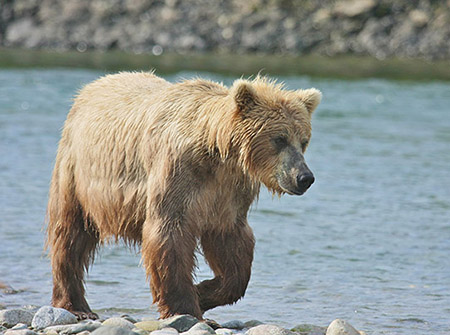
A McNeil River brown bear. ADF&G photo.
Regardless of the motivations behind it, many of Merriam’s contemporaries found his proposed taxonomy outlandish. Even so, without a large series of additional morphometric data and accompanying field observations, Merriam’s work was hard to refute, and it remained the accepted brown bear/grizzly taxonomy for decades. Then in 1963, a researcher named Robert L. Rausch published his own findings that reduced the number of grizzly and brown bear species in North America from seventy-eight to one.
Stationed in Alaska with the Zoonotic Disease Section of the U.S. Public Health Service’s Arctic Health Research Center, Rausch spent a number of field seasons in the Brooks Range during the 1950’s; surveying, sampling, and collecting specimens of the wildlife found in the region. Through the course of his time there, he couldn’t help but notice that there was a high degree of variation in the skulls of bears that he was obtaining, despite inference (and common sense) indicating that they all belonged to one interbreeding population. With this natural variability in mind, Rausch was convinced that the grizzlies and brown bears of North America all belonged to one single species, which at most could be subdivided into a handful of subspecies.
After obtaining over 350 skulls from adult male brown bears across the animals’ North American range and comparing skull measurements that indicated only a bear’s overall size, Rausch determined that bear size was “clinal” in nature, with average body size for any given population sitting along a spectrum with adjacent populations. The largest averages were found among the bears of the southwestern Alaska coast, and the further east or north one went from this region, the smaller the average body size became. This data, together with the wide variability in other physical features within a given population, led Rausch to conclude that distinct subspecific status among the majority of North American brown bears and grizzlies was not warranted as no clean delineations could be observed from one intergrading population to the next.
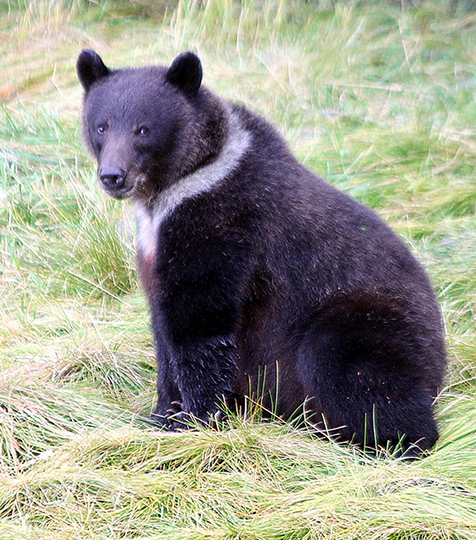
Young brown bears sometimes display a “natal collar” marking that may disappear as they grow up, or fade on top leaving a “chevron” V mark on the chest. Photo by Phil Mooney at Port Armstrong on Baranof Island.
The Fabled Kodiak
The one exception to Rausch’s single North American subspecific designation were the bears inhabiting the Kodiak Archipelago. Comprised of Kodiak, Afognak, and many smaller associated islands, the archipelago has been home to brown bears since the end of the last Pleistocene glaciation, when bears colonized the islands from mainland Alaska.
Just exactly how bears accomplished this feat has been lost to time, as today the shores of the largest island, Kodiak, are separated by about 22 miles from the mainland by the often tempestuous Shelikof Strait. Perhaps with sea levels lower due to much of the world’s water locked up in vast but retreating continental glaciers, the distance between Kodiak and the mainland was significantly narrower during the late Pleistocene and bears were able to swim the distance. Or perhaps climactic conditions of the time allowed sea ice to form along the southern Alaska coast during the winter and intrepid bears simply walked to the island that they could see in the distance after first emerging from their dens in early spring.
Regardless of what conditions first allowed bears to reach the islands, it is impossible for a bear to do so today, meaning that those found on the Kodiak Archipelago have been isolated from their mainland cousins by at least 12,000 years.
Long-renowned among hunting and outdoors circles and distinguished by their large size (some exceptional males can reach over 1,500 lbs. in weight) and relatively broad, blocky heads, Kodiak bears were first described scientifically by none other than C. Hart Merriam. In 1896 he conferred full species status to the bears, designating them Ursus middendorffi, named for the Russian zoologist Alexander von Middendorff who had done much work describing the large coastal brown bears of Kamchatka (which Merriam most closely associated with the Kodiak bears). As it turns out, Merriam naming a “species” of bear after Middendorff is incredibly ironic, as Middendorff himself proposed as early as 1851 that all of the brown and grizzly bears of North America were the same species as those found in Eurasia.
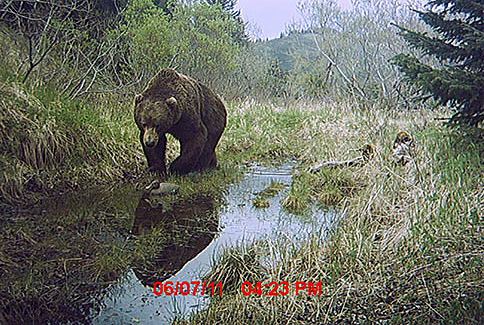
A Kodiak bear, photographed by Robin Overall using a motion-triggered trail camera.
In the decades following Rausch’s streamlining of brown bear taxonomy, other researchers, using different morphological criteria, argued for additional mainland Alaska subspecies to be recognized, renewing the deep-rooted debate between lumpers and splitters. In everyone’s models, however, the Kodiak bears were always recognized as distinct and isolated enough to warrant separate taxonomic status, and were thus considered by all to be a “good” or valid subspecies.
This general taxonomic view – with one subspecies found on the Kodiak Archipelago and between one and nine additional subspecies throughout the rest of the continent – would prevail for many decades, until new technologies at the turn of the 21st Century allowed fresh perspectives and brought unexpected new insights that would once again call the established understanding of North American brown bears into question.
In next month’s issue, we will conclude our story with an examination of the current understandings of Alaskan brown bear genetics, the different factors that influence bear body size between regions, and the cultural traditions that have contributed to the perseverance of the various common names for Ursus arctos throughout Alaska.
Wilson Puryear is a Fish and Wildlife Technician who works primarily at the Sport Fish Information Center within ADF&G’s Anchorage office.

